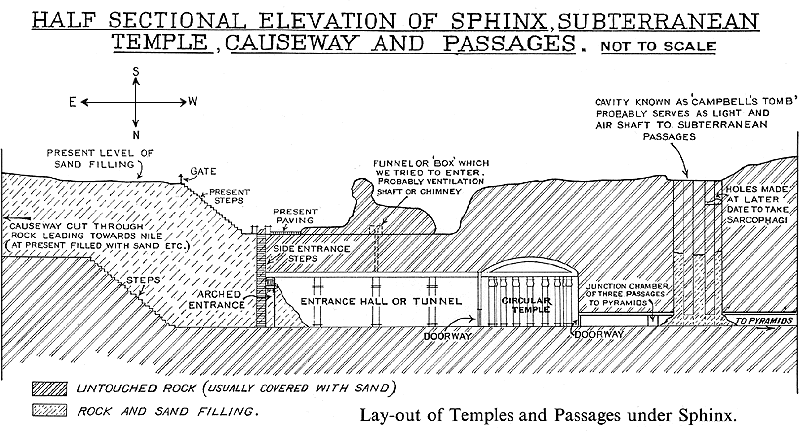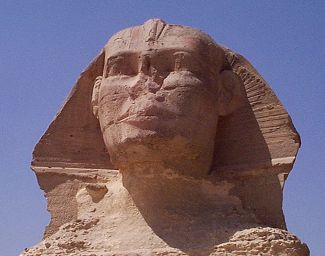 |
 |
| The Sphinx |
| Up from Legend A Sphinx is a being with the head of a human and the body of a lion. In ancient Egypt, the head might assume the face of the reigning pharaoh who, along with the Sphinx, was the earthly representation of the sky-god, Horus. In addition, the lion symbolizes kingship and courage. From Egypt, the idea of the Sphinx spread to Syria, Phoenicia, and Greece where the sphinx assumed the head and bust of a woman, and added an eagle's wings and a long serpent's tail. In Greek legend, it was the Sphinx who put forth a riddle to all passersby and devoured those who failed to guess the correct answer. Oedipus solved the riddle and so caused the Sphinx's death. In later Greek literature, the Sphinx became a wise and mysterious woman. |
 |
| The head of the Great Sphinx measures 19 feet from the top of the forehead to the bottom of the chin, the face is 20 feet wide, and 91 feet in circumference. Remaining flecks of paint indicate the Sphinx may once have been painted bright red. The upper portion of the paws extend forward 56 feet, the body is 172 feet long (total body length is 242 feet), and the height to the top of the head is 66 feet. Pharaoh Amenhotep II (1448-1420 B.C.) mentioned that the Sphinx was older than the Pyramids and generally considered to have been buried in sand until Thutmosis IV (18th Dynasty, 1420-1411 B.C.) had a dream of a god telling him to clear the sand away. The stela he put up between the paws was discovered when the Sphinx was cleared of sand in our time. A partially-eroded hieroglyphic phrase -- translated as "praise to Un-nefer [Khafre] the statue made for Atum-Harmakhis" -- was found near the bottom of the stela. Egyptologists point to this as evidence that Khafre built the Sphinx. Others disagree. Some time after it was excavated, the inscription flaked off. Now only drawings remain. In 1379, as reported by the Arab author Al Maqrizi, a man named Saim el Dahr hacked off the Sphinx's nose. The sacrificial altar now seen between the paws was constructed by the Romans. Medieval and renaissance visitors took pieces of the Sphinx's headress and face for talismans and remedies. During the 17th and 18th centuries, invading Marmalukes and French soldiers reportedly used the head for target practice. This article is one of two about the controversies swirling like sand about the Great Sphinx on the Gizeh plateau. |
 |
| Priority for examining this tunnel appears to be low. This work was confirmed and incorporated into the film, "The Mystery of the Sphinx" made in 1992-1993 about author/Egyptologist, John Anthony West; Robert M. Schoch, Professor of Geology at Boston University; and geophysicist/seismologist, Thomas Dobecki from the Houston firm, McBride-Ratclif & Associates. Shown on NBC, the film was produced by Boris Said of Magical Eye, Inc., and Bill Cote of BCVideo; and, according to some reports, was partly financed by members of the Association for Research and Enlightenment (A.R.E.). Headquartered in Virginia Beach, Virginia, A.R.E. is the organization that promulgates the work of psychic, Edgar Cayce, the sleeping prophet. Cayce predicted it would be discovered that the Sphinx had been built in 10,500 B.C. by survivors from the break-up of the continent of Atlantis. In addition, concealed beneath it, a Hall of Records would be discovered that would contain all the collective wisdom from their lost civilization and the true history of the human race. Cayce predicted the Hall of Records would be found and opened by 1998. |
 |
The Great Sphinx at Gizeh The greatest Sphinx of all, called by Arabs "Abu el-Hol," the Father of Terror, is the Great Sphinx of Gizeh, who gazes enigmatically across the Nile towards the rising sun with its back towards the three great pyramids. Its head and bust were carved from a natural outcrop of solid limestone and the paws were built up with stone. |
| This first article will treat the passages in and under the Sphinx. The second article will deal with the controversy surrounding the age of the Sphinx. A third article will concentrate on the Great Pyramid and an update on the airshaft or starshaft in the Queen's chamber. |
| The Newly Rediscovered Passage in the Sphinx Halfway between the Sphinx's front paws and its curved tail, workers restoring the Egyptian Sphinx became intrigued by a patch of rocks and discovered an ancient passageway leading deep into the statue's body. The team consulted thousands of old photographs and discovered a photograph taken during a 1926 restoration which was begun after the Sphinx was dug out of the sand. The photo showed a man standing at the entrance to this passage. The passage was sealed with new blocks but restorers at the time never recorded what, if anything, had been found. |
| In the film, Dobecki is shown taking seismic readings of a known underground chamber behind the rump of the Sphinx to establish a reading for a known underground chamber, then took seismic soundings of the area beneath the area in front of the Sphinx where a cavity was indicated by seismic readings similar to the posterior cavity. This anterior (front) cavity was rectangular in shape and measured nine meters by 12 meters and was about five meters below the surface. Dobecki and Shoch wrote: "Both teams' [SRI and the Japanese] showed best agreement in the detection of a possible rubble-filled void in the area of the Sphinx's paws as well as indications of potential cavities or tunnels extending under the Sphinx as detected along its flanks." [Dobecki and Schoch, 1992; Seismic Investigation in the Vicinity of the Great Sphinx of Giza, Egypt, "Geoarchaeology," Vol 7, No 6, pp 527-544] |